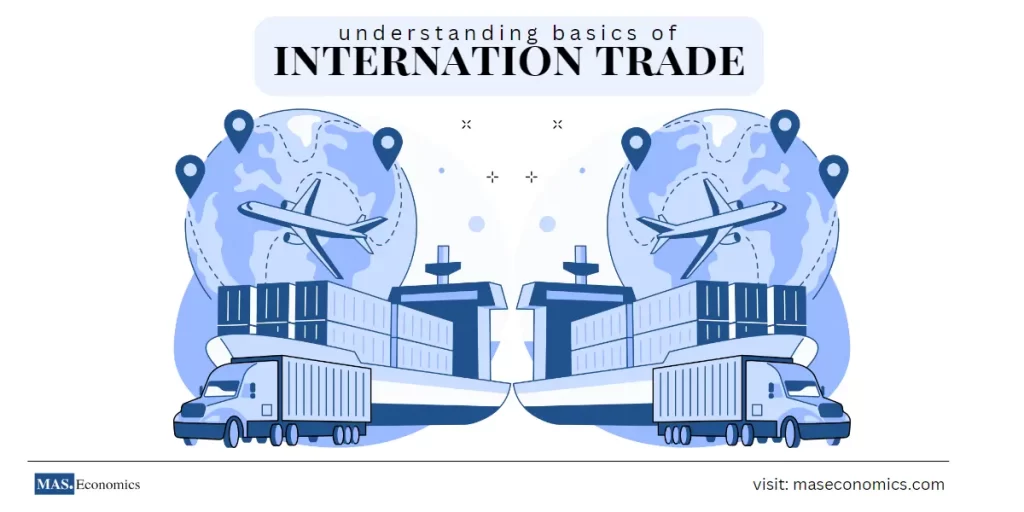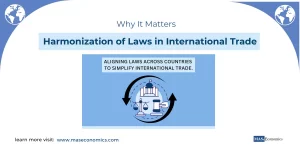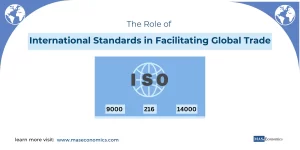International trade is not a new concept. From the Silk Road to modern-day globalization, it has been a defining factor in human history. The exchange of goods and services between countries has allowed civilizations to prosper, sharing innovations and resources that drive growth. Today, international trade is the backbone of the global economy, enabling countries to leverage their comparative strengths for higher productivity and improved living standards.
In fact, according to the latest UNCTAD forecasts, global trade is expected to approach nearly $32 trillion in 2024. This unprecedented growth is driven by key sectors like Artificial Intelligence (AI) and green energy, which are making significant gains in international markets. These transformative industries underscore how modern trade continues to shape the global economy, just as historical trade routes did centuries ago.
What is International Trade?
International trade refers to the process of exchanging products and services between two or more countries. It is influenced by factors like economies of scale, comparative advantage, absolute advantage, and competitive asymmetry in markets. Facilitated through mechanisms such as tariffs, export subsidies, import licensing, and quota agreements, international trade allows nations to access resources that are scarce domestically, fostering economic growth and development.
Closed vs. Open Economies
Early economic thinkers were often skeptical of trade. Many believed that keeping an economy closed, meaning not engaging with international trade, was the best way to protect domestic interests. This was largely influenced by mercantilist thinking, which viewed trade as a zero-sum game—one country’s gain is another’s loss.
Closed Economy
A closed economy, also known as autarky, does not engage in international trade. Everything the economy needs in this system is produced domestically, with no imports or exports. This concept appealed to earlier thinkers who believed that self-reliance was key to economic stability and growth. Countries following a closed economy model sought to be entirely self-sufficient, without depending on outside goods or services.
Historically, autarkic economies were seen in countries like North Korea, which aimed to eliminate external economic influences. However, the limitations of such a system are clear: countries lose out on the benefits of specialization and access to resources that may not be available within their borders.
To see the economic limitations of a closed economy, consider this equation:
- \( C \) is consumption,
- \( I \) is investment,
- \( G \) is government spending.
Without international trade, this equation lacks net exports (NX), limiting economic growth potential. For example, suppose a country produces all its food, energy, and goods, but cannot import raw materials or advanced technologies. In that case, it may not grow as quickly or efficiently as an open economy.
Open Economy
As thinkers like Adam Smith and David Ricardo emerged in the 18th and 19th centuries, they introduced ideas that revolutionized the understanding of trade. Adam Smith’s landmark work, The Wealth of Nations, emphasized the importance of free trade and absolute advantage. He argued that when countries produce goods they are more efficient at and trade with others, they can benefit from the efficiencies of the global market.
As trade theory evolved, so did the understanding of how open economies thrive by trading with others. David Ricardo later introduced comparative advantage, a concept that suggests even if one country is more efficient at producing everything, both countries can still benefit by specializing in what they do relatively better.
In today’s globalized world, open economies dominate. They engage with the world market, benefiting from access to resources, capital, and technology that may not be available domestically. The modern open economy equation includes net exports (NX):
By adding net exports to this equation, open economies experience higher levels of growth. For example, a country like Germany, with its strong export sector, can grow its economy through the sale of automobiles, machinery, and chemicals to global markets.
Key Theories in International Trade
Adam Smith’s Absolute Advantage
Adam Smith introduced the concept of absolute advantage, which argues that if a country can produce a good more efficiently than another, it should specialize in producing that good and trade for others. The core idea here is to focus on what you’re best at producing with fewer resources than anyone else.
Example of Absolute Advantage:
Consider two countries: Pakistan and the United States. Pakistan can produce 10 tons of wheat or 5 cars per year. The United States, on the other hand, can produce 20 tons of wheat or 15 cars in the same time. Clearly, the U.S. has an absolute advantage in producing both goods because it can produce more of both wheat and cars than Pakistan.
Let’s express this in terms of productivity:
| Wheat (tons/year) | Cars (units/year) | |
|---|---|---|
| Pakistan | 10 | 5 |
| U.S. | 20 | 15 |

|
||
In terms of output per worker or per resource used, the U.S. is clearly better at producing both. However, according to absolute advantage, the U.S. should specialize in what it produces most efficiently (in this case, cars) and trade with Pakistan for wheat. This allows both countries to enjoy a higher quantity of goods than if they tried to produce everything themselves.
Gains from Trade:
Without trade, assume each country spends half of its resources producing each good:
- Pakistan produces 5 tons of wheat and 2.5 cars.
- The U.S. produces 10 tons of wheat and 7.5 cars.
After specialization and trade:
- The U.S. fully specializes in cars (15 cars) and trades some of its cars with Pakistan.
- Pakistan specializes in wheat (10 tons) and trades wheat for cars.
If Pakistan trades 3 tons of wheat for 3 cars with the U.S., the outcome is:
- Pakistan ends up with 7 tons of wheat and 3 cars.
- The U.S. ends up with 13 cars and 3 tons of wheat.
Through trade, both countries enjoy more cars and wheat than they could produce alone!
David Ricardo’s Comparative Advantage
David Ricardo built on Adam Smith’s theory by introducing comparative advantage—even if one country has an absolute advantage in producing all goods, there is still a way for both countries to benefit by specializing in what they produce at a lower opportunity cost.
Example of Comparative Advantage:
Let’s revisit Pakistan and the United States. Suppose the U.S. can produce both wheat and cars more efficiently, but the opportunity cost of producing cars in the U.S. is higher than in Pakistan. Even though the U.S. can produce both goods more efficiently, comparative advantage shows us that both countries can still gain from trade by specializing based on their opportunity costs.
Let’s say:
- In the U.S., the opportunity cost of producing 1 car is 1.33 tons of wheat.
- In Pakistan, the opportunity cost of producing 1 car is only 2 tons of wheat.
| Wheat (tons/year) | Cars (units/year) | Opportunity Cost (Cars in terms of Wheat) | |
|---|---|---|---|
| Pakistan | 10 | 5 | 2 tons of wheat per car |
| U.S. | 20 | 15 | 1.33 tons of wheat per car |

|
|||
The U.S. has a comparative advantage in producing cars (lower opportunity cost), while Pakistan has a comparative advantage in producing wheat (it gives up less wheat to produce a car).
Gains from Trade:
If the U.S. specializes in cars and Pakistan specializes in wheat, both can trade and gain. Assume:
- The U.S. specializes in cars and produces 15 cars.
- Pakistan specializes in wheat and produces 10 tons of wheat.
If they trade 5 tons of wheat for 4 cars, then:
- Pakistan ends up with 5 tons of wheat and 4 cars.
- The U.S. ends up with 10 cars and 5 tons of wheat.
Both countries benefit by receiving more of both goods through trade than they would by producing both goods themselves!
Heckscher-Ohlin Theory
The Heckscher-Ohlin model takes the concept of comparative advantage further by explaining that countries should specialize in producing goods that use their abundant resources intensively—capital or labor.
Example:
Let’s imagine the U.S. is a capital-abundant country (more machines and technology) and Pakistan is a labor-abundant country (more workers). According to the Heckscher-Ohlin model, the U.S. should specialize in producing capital-intensive goods like electronics and machinery, while Pakistan should focus on labor-intensive goods like textiles.
Suppose each country can allocate its resources toward the production of capital-intensive or labor-intensive goods:
| Capital-Intensive Goods (units/year) | Labor-Intensive Goods (units/year) | |
|---|---|---|
| U.S. | 50 | 30 |
| Pakistan | 20 | 60 |

|
||
The U.S. should focus its resources on producing capital-intensive goods, and Pakistan should focus on labor-intensive goods. After specialization, the U.S. can trade its capital-intensive goods with Pakistan for labor-intensive goods. Both countries benefit by accessing goods they do not efficiently produce themselves.
Conclusion
International trade, driven by concepts like absolute advantage, comparative advantage, and the Heckscher-Ohlin theory, demonstrates that countries stand to gain by specializing in what they produce best and trading with others. Through practical and mathematical examples, we’ve seen how nations like the U.S. and Pakistan can leverage their strengths and improve their economic output through mutually beneficial trade.
From the historical shift between closed and open economies to the key theories that explain the benefits of trade, we have explored how trade allows countries to specialize, increase efficiency, and maximize their gains from trade.
FAQs:
What is international trade?
International trade is the exchange of goods and services between countries, allowing access to global resources and markets, driving economic growth, and fostering specialization.
Why is international trade important?
It boosts economic growth, creates jobs, and allows access to a broader range of goods, services, and technologies, benefiting both consumers and producers.
What is the difference between a closed and an open economy?
A closed economy doesn’t engage in trade and relies on domestic production, while an open economy trades internationally, benefiting from global markets and resources.
What is the absolute advantage?
Absolute advantage occurs when a country can produce a good more efficiently than another, using fewer resources.
What is comparative advantage?
Comparative advantage focuses on producing goods at a lower opportunity cost, allowing countries to benefit from trade even if one has an absolute advantage in all products.
How do absolute and comparative advantage differ?
Absolute advantage is about overall efficiency in production, while comparative advantage is about specializing where opportunity costs are lowest for mutual trade benefits.
What is the Heckscher-Ohlin theory?
It suggests that countries should export goods that use their abundant resources intensively (e.g., labor or capital) and import those that require scarce resources.
How do countries benefit from international trade?
Countries benefit by specializing in goods where they have an advantage, increasing production efficiency, accessing larger markets, and promoting economic growth.
What are examples of closed economies?
North Korea is an example of a closed economy, aiming for self-sufficiency and minimizing trade with other countries.
How does international trade affect economic growth?
It expands markets, improves efficiency, attracts investment, and encourages innovation, leading to higher productivity and economic growth.
What is an example of absolute advantage?
The U.S. has an absolute advantage over Pakistan if it can produce more cars and wheat using the same resources.
How does comparative advantage create trade benefits?
Comparative advantage allows countries to specialize and trade for goods they produce less efficiently, increasing overall global output.
Why do countries adopt open economy models?
To access global markets, attract investment, and benefit from specialization and technology transfer, leading to greater economic growth.
What are the limitations of a closed economy?
Closed economies miss out on specialization, innovation, and access to global resources, leading to slower growth and fewer opportunities for improvement.
How does the Heckscher-Ohlin model explain trade?
It explains that countries export goods that use their abundant resources and import those requiring resources they lack, shaping trade patterns.
Thanks for reading! If you found this helpful, share it with friends and spread the knowledge.
Happy learning with MASEconomics



